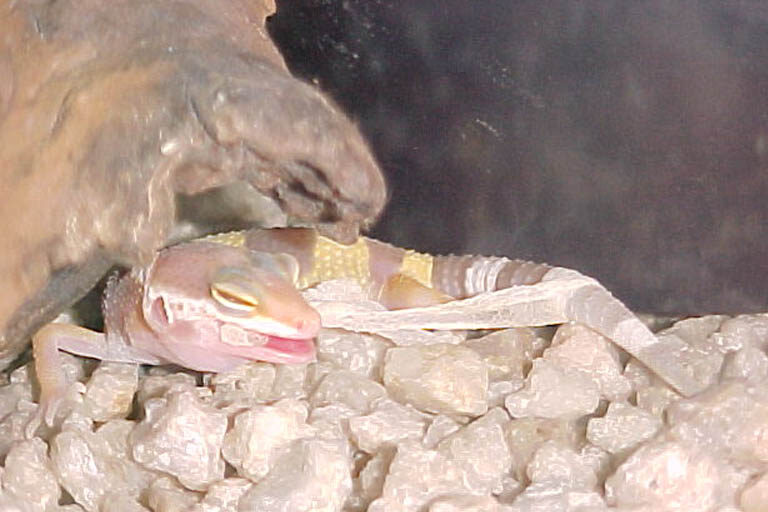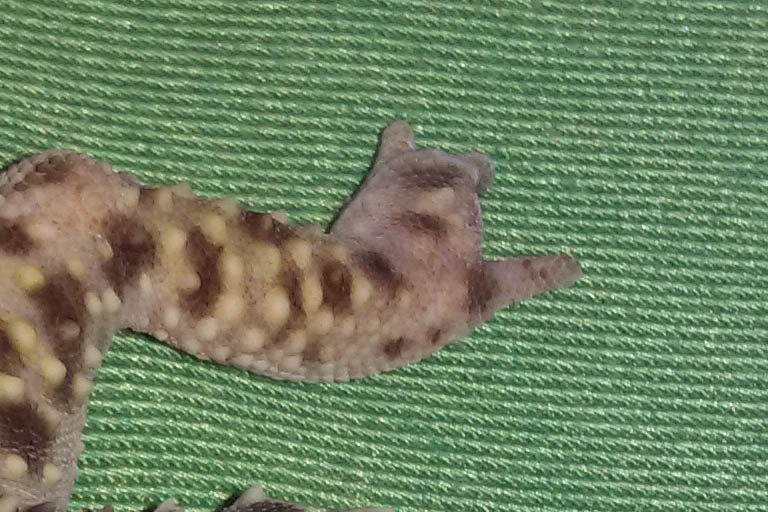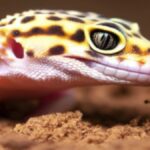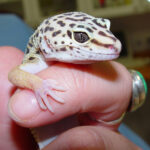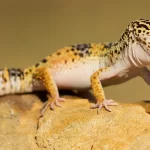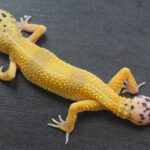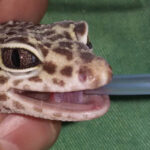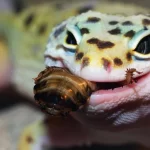 As with other reptiles, Leopard geckos go through multiple skin sheds throughout their lives. Unlike most other reptiles, they also eat their shed skins.
As with other reptiles, Leopard geckos go through multiple skin sheds throughout their lives. Unlike most other reptiles, they also eat their shed skins.
Introduction to skin eating in Leopard geckos
Leopard geckos are known to eat their sloughed skins(32)(59)(62). Skin eating is called ceratophagia, which, more specifically, means ‘horn eating’. Although this behaviour is rarely seen in other animals, it is not abnormal, or even unique to, Leopard geckos.
Skin eating behaviour is also documented in other geckos(54), such as African fat tail geckos (Hemithiconyx caudicinctus)(58) and Banded geckos (Coleonyx variegatus)(61), other reptiles and crustaceans.
With healthy Leopard geckos, the old skin will most often be sloughed as one piece(54)(62) or a couple of large pieces. These pieces of dead skin are often seen being bitten and pulled off by the Leopard gecko — ending in being chewed and swallowed. Shedding will often take place at night(30) and when the old skin was eaten, the process will often be missed, but smaller pieces of non-eaten skin might be found lying around in the enclosure.
Also see
Leopard gecko skin shedding — an ‘a pealing’ affair Donate via PayPal
Leopard Geckos 101 is a free, informative website helping to improve the quality of pet Leopard geckos. If you found value in any of its content, please consider making a donation. Also see the other ways to support Leopard geckos 101.
Why Leopard geckos eat their skins
Although the reasons for skin eating behaviour in Leopard geckos are not fully understood, there are a few theories that do exist. By looking at why some other animal species eat their sloughed skins, one can get a little insight into why Leopard geckos might be doing the same. This question has also been answered in short on the UCSB Science line.
Regaining lost nutrients
Some experts believe that by eating their own dead skin, Leopard geckos reuse some of its minerals and nutrients that were contained in the dead skin.
Living in dry, desert environments can be tough and certain required minerals are scarce. Sloughed, dead skin is a valuable source of many minerals. By eating the skin, Leopard geckos are actually ‘recycling’ valuable minerals. Some believe that dead skin also contains re-usable energy.
Concealing their territories
Experts also believe that skin eating behaviour in Leopard gecko is instinctively and serves as a protection mechanism against natural predators. Pieces of sloughed skin can give predators, and other Leopard geckos, an indication where there might be a meal nearby. It might also leave a smell behind.
By eating their own sloughed pieces of skin, no such evidence exists. This way predators are less likely to hang around, making their environments a little safer.
While watching a Leopard gecko eating its skin, it also becomes evident that by physically pulling the dead skin from the body, the shedding process is hastened and made easier. Pieces of dry skin that remains stuck to the body can hinder normal movement and cause life-threatening blood loss to some areas. Skin infections are also more likely during difficult shedding.
A Leopard gecko foot where the toes have been lost due to retained skin after a difficult shed. By pulling the skin off and eating it, Leopard geckos can reduce the chances of retained skin. Image © Renier Delport
Dead pieces of skin are known to cause the loss of toes, tails, feet and even legs. During the shedding process, a Leopard gecko is also left fragile and becomes an easy target for predators. Making the skin shedding process faster, less energy is consumed and normal activity can resume within a shorter period of time which ultimately reduce the chance for being caught.
Also see
Skin shedding problems in Leopard geckos
Conclusion
Although concrete evidence is lacking on why Leopard geckos eat their sloughed skins, some theories exist. They include regaining lost nutrients, concealing their territories and aiding in the skin shedding process.

